The Role of Fine Art in the Environmental Issues
"The quality of place, the reaction to immediate contact with earth and growing things that have a fugal human relationship with mountains and sky, is essential to the integrity of our existence on this planet," the famous American photographer Ansel Adams wrote in his autobiography. From the romantic painters of the belatedly 18th century to Adams to contemporary figures like Pedro Reyes and Agnes Denes, artists accept long had a fascination -- and deep respect -- for the planet on which nosotros exist.
With the words "global warming" and "climate change" never far from the headlines, artists like Adams and co. are more relevant than ever. Tying together the scientific and creative worlds in acts of beauty and activism, sculptors, painters, photographers and more have the power to make environmentalism a priority and bring dark-green initiatives to the forefront of cultural conversations. Behold, xviii light-green artists who are making climate change and conservation a priority.
1. Olafur Eliasson's Icebergs
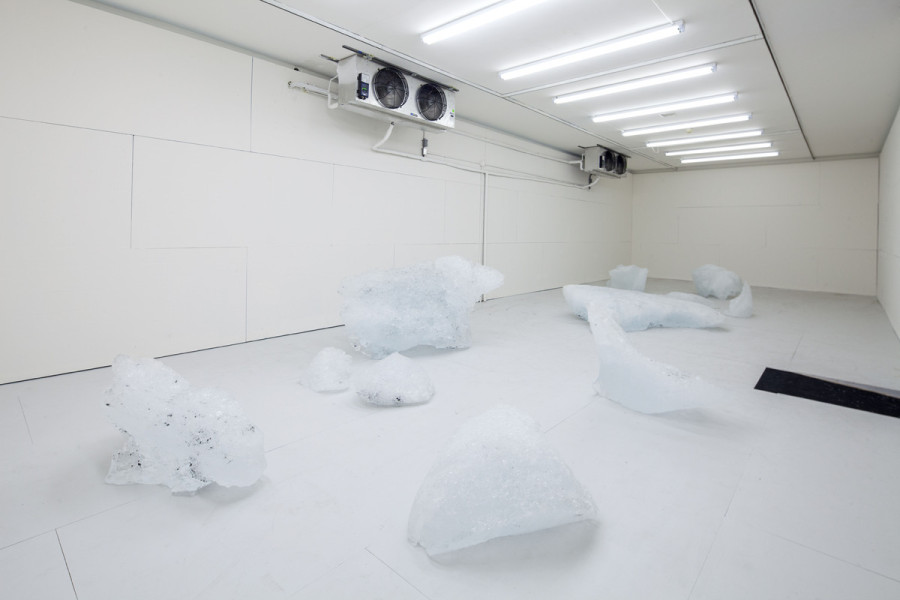
Olafur Eliasson. Your waste material of time. 2013. Installation view of EXPO 1: New York at MoMA PS1. Photograph: Matthew Septimus.
For "Your waste material of time," Olafur Eliasson displayed pieces of ice that broke off from Republic of iceland's largest glacier, Vatnajökull. Exhibited in a refrigerated gallery space powered by solar panels, the ice "sculptures" represented 800 years of Earthly existence, putting human'southward physical experience in perspective. "The obvious lesson of Mr. Eliasson'south installation, 'Your waste of time,' is that global warming is wreaking havoc on nature," Ken Johnson wrote in The New York Times last yr.
2. David Maisel's Photographs of Open up Pit Mines
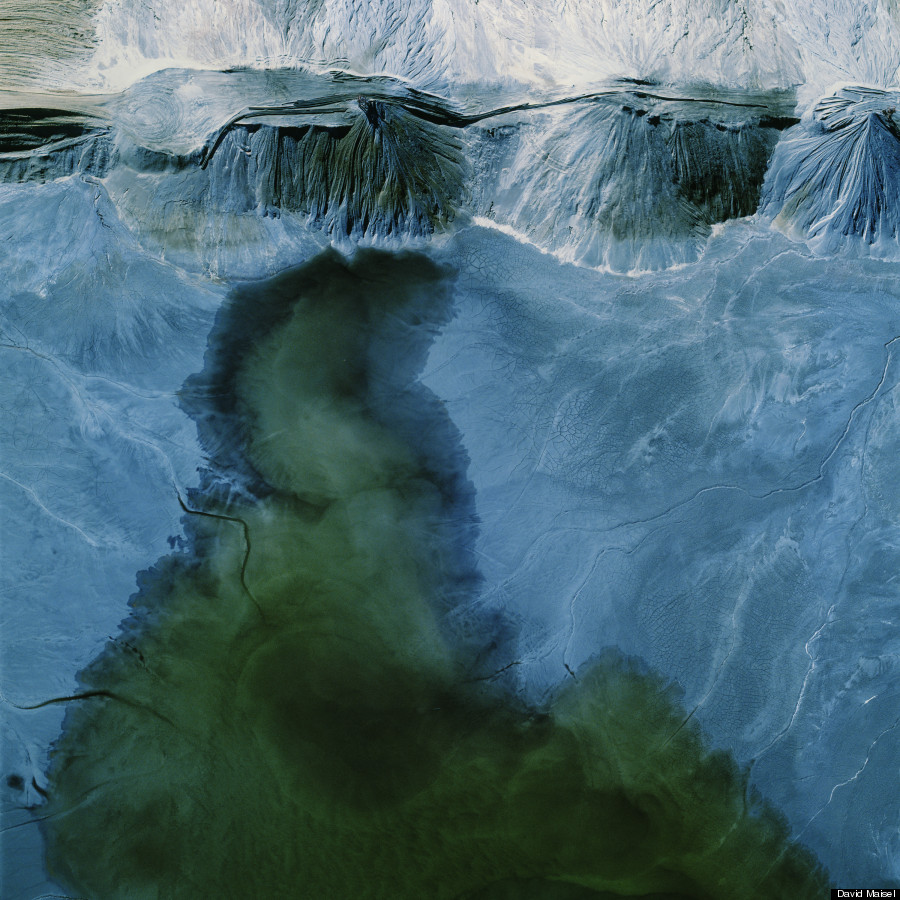
David Maisel, The Mining Projection (Butte, Montana 9), 1989, Archival Pigment Print, 2013, 48 10 48 inches, Edition of 5, Courtesy of the artists and Haines Gallery
At first glance, David Maisel'southward gorgeous photographs seem to celebrate the natural beauty of some other planet, but his deep blue swirls and cherry craters really describe the aerial appearance of environmentally impacted sites in the United States transformed by water reclamation, logging, military tests and mining. "With the mining sites, I found a bailiwick thing that carried forth my fascination with the undoing of the landscape, in terms of both its formal dazzler and its environmental politics," Maisel writes on his website.
3. Luzinterruptus' Waste Labyrinth
The art collective Luzinterruptus has a history of tackling political and social issues in Europe. The "Labyrinth of Plastic Waste product" is merely one example.
"We were looking to demonstrate, in a poetic manner, the amount of plastic waste that is consumed daily," Luzinterruptus explained in a statement. "In add-on to focusing attending on the big business of bottling water, which leads to very serious problems in developing countries, whose citizens take watched as their aquifers have been privatized with impunity for the sectional enrichment of large business owners and ruling classes without scruples."
4. Amanda Schachter and Alexander Levi'southward Harvest Dome

Architects Amanda Schachter and Alexander Levi's massive "Harvest Dome ii.0," assembled from 450 umbrellas and 128 bottles, once floated around the inlet of Inwood Colina Park in New York Metropolis. Deemed a slice of "operation compages," the 24 by 18-foot structure further proves the world's garbage can nosotros reused in many unexpected ways.
5. John Sabraw's Toxic Sludge Paintings
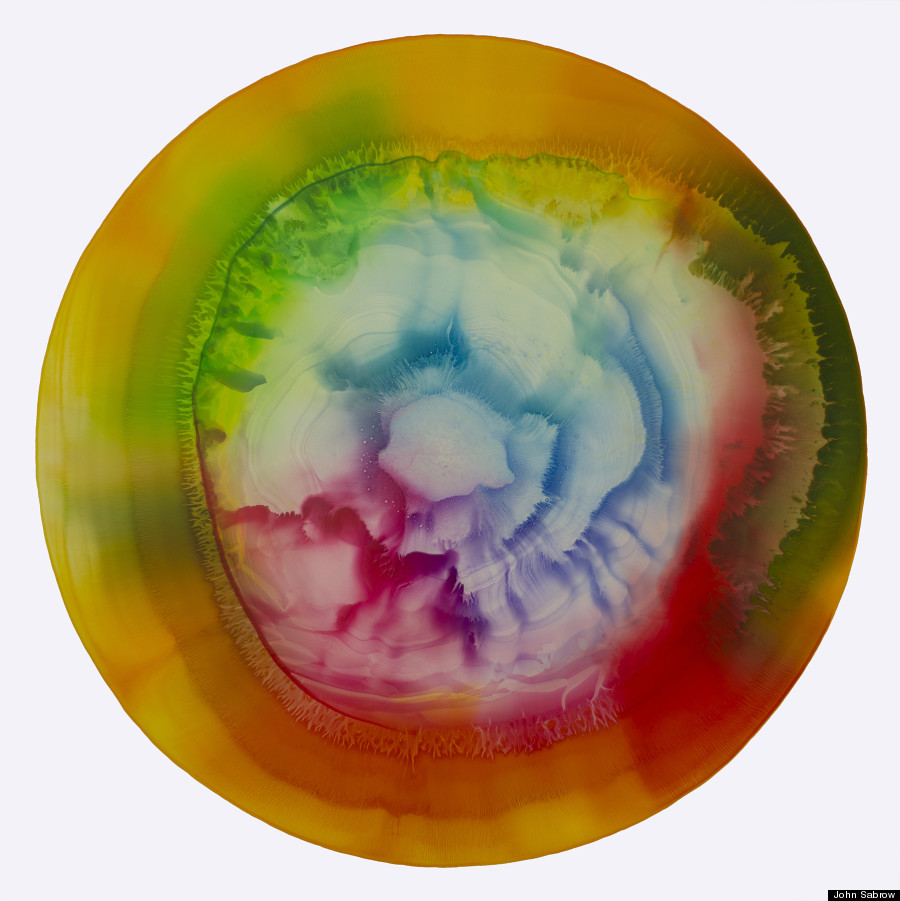
Using toxic runoff found in the Ohio River region, artist and professor John Sabraw produces his ain DIY pigments -- bold yellows and reds that are sourced from the oxidized sludge of abandoned coal mines. Rather than using imported fe oxide from China to make his pigment colors, he taps into the water's heavy metals left over from abandoned coal mines, bringing to light the region's pollution trouble in the process.
"The creative person, like the scientist, has a crucial office to perform in our social club," Sabraw explained to HuffPost. "See things differently, act on this vision, report the failures and successes."
vi. Naziha Mestaoui's Virtual Forests

Naziha Mestaoui'south "One Beat One Tree" projects virtual forests onto city spaces, blurring the boundaries between the natural earth and advancing technology. The digital copse actually abound in rhythm with a person's heartbeat, as viewers can connect to the serial via a smart phone sensor. And with each virtual establish, a physical one is grown in regions throughout the world, from Europe and Latin America to Africa and Asia. Since its inception two years ago, the project has already sparked the growth of xiii,000 trees.
7. Rachel Sussman's Oldest Things

Photographer Rachel Sussman has been traveling the globe for the past 10 years, searching for the globe'due south oldest living things with photographic camera in tow. From the Mojave Desert to the Australian Outback to Greenland'due south icy expanses, she captures portraits of organisms capable of lasting for lxxx,000 years, shining a lite on our planet's resilience in the face of human intervention. "Farthermost longevity can lull us into a simulated sense of permanence," Sussman wrote for Encephalon Pickings. "But being old is not the same as being immortal."
8. Barry Underwood's Electric Landscapes
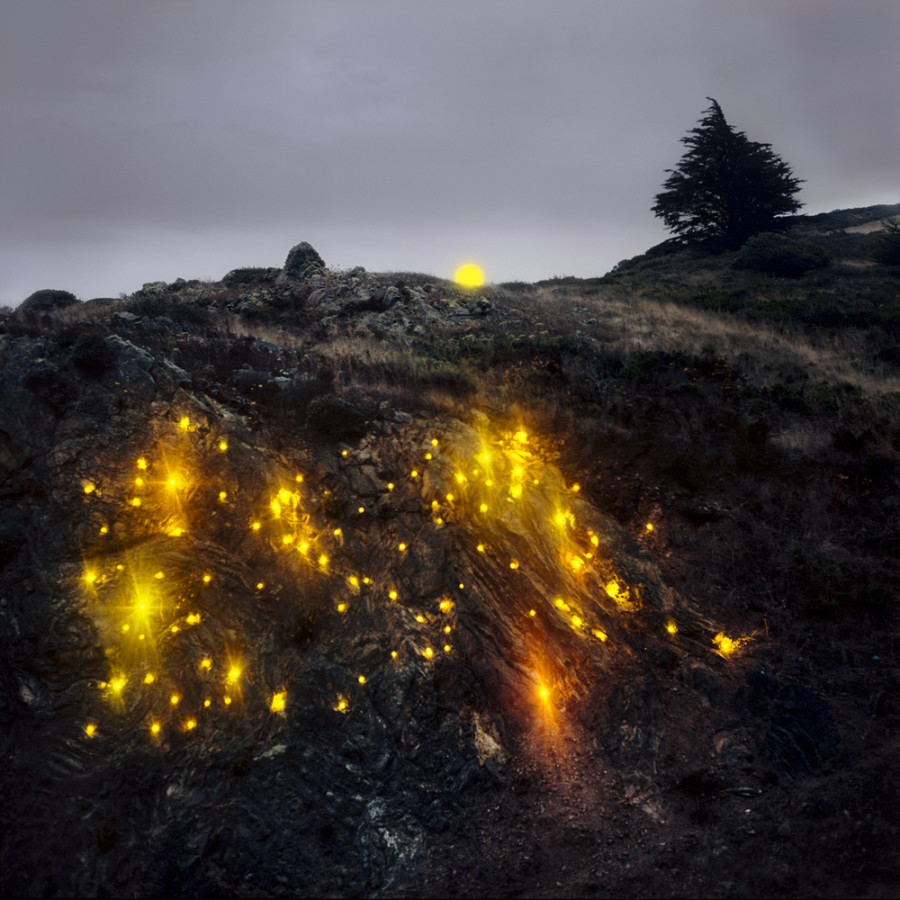
Headlands (Outcrop)
Combining elements of painting, photography, performance, cinema and land fine art, Barry Underwood renders environmental issues similar light pollution and deforestation in electric splendor."My try is to portray environmental issues that are not delivered in a heavy-handed manner," Underwood explained to HuffPost. "Rather in a mode that draws attending in a pleasing way, so if contemplated could unfold a bulletin of dissidence or a natural discord."
ix. Paulo Grangeon's 1,600 Pandas.
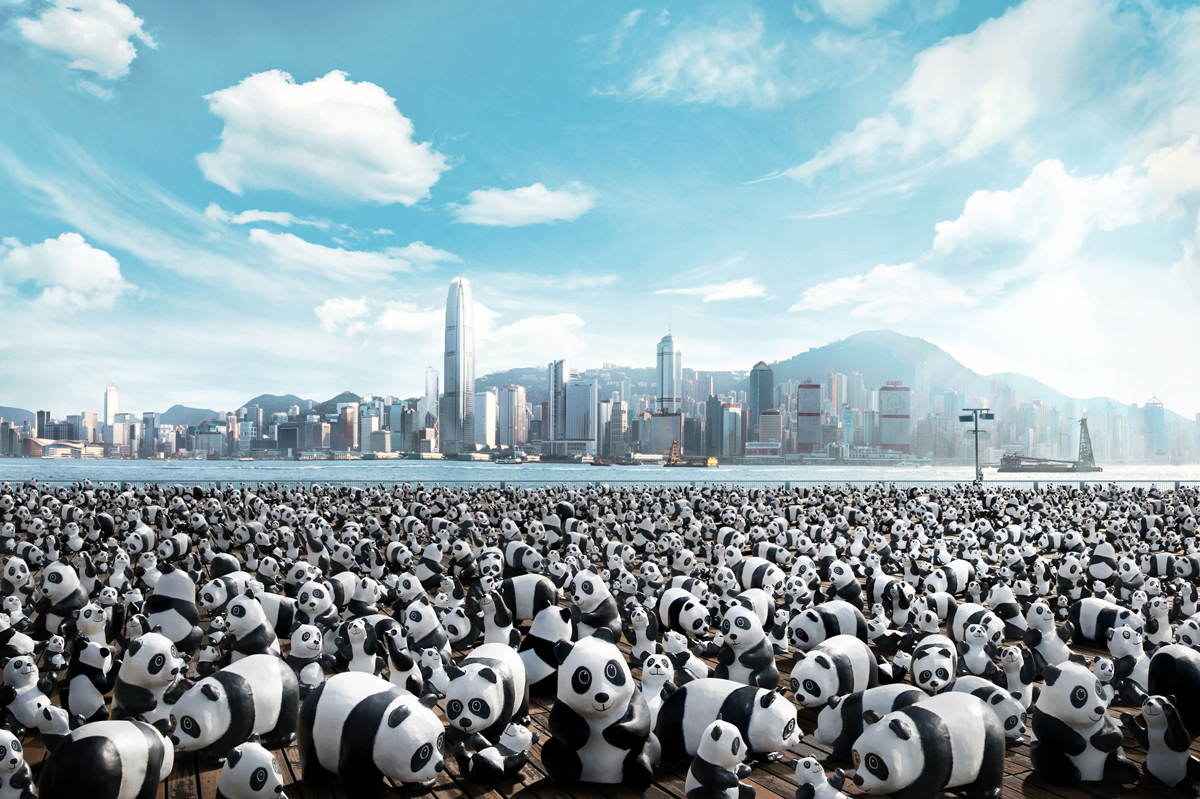
French sculptor Paulo Grangeon used an unlikely medium to illuminate the reality of animate being endangerment across the world. For his traveling exhibit, "Pandas on Tour," he created 1,600 papier-mâché bears meant to represent the actual number of pandas left on the planet (recent estimates actually place the number slightly below that, at 1,596). Launched in 2008 in collaboration with the Globe Wildlife Fund, Grangeon'south projection has traveled to landmarks in more than 20 countries, including the Eiffel Tower.
10. Daan Roosegaarde'due south Vacuum
Ask a Dutch artist to solve the problem of blanket pollution in Beijing and what do you get? If you've tracked downwardly Daan Roosegaarde, y'all'll get "Smog," a system of secret copper coils meant to suck up airborne particles using an electrostatic field. It's like a vacuum cleaner that operates on a similar principle to statically charged balloons.
11. Aida Sulova'due south Trash Cans

A Kyrgyz street artist named Aida Sulova confronted the rampant garbage problem in Bishkek by using trash bins as a canvas. According to Wooster Collective, the street artist pastes photographic images of open up mouths on garbage cans throughout the city to "remind people that what they throw into the world, somewhen ends upwardly inside u.s.a.."
12. Chris Jordan's Portraits of Consumption
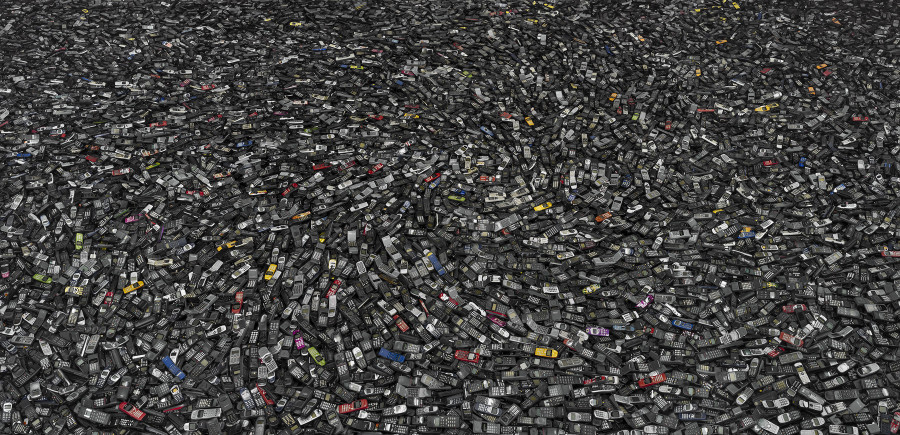
Cell phones #2, Atlanta 2005
Photographer Chris Jordan puts consumption into perspective with his series "Intolerable Dazzler: Portraits of American Mass Consumption." His works bear witness the debris we as a guild leave backside, from massive dumps of cell phones, to crushed cars and circuit boards, all squeezed together in hypnotic quantities. "I am appalled by these scenes, and nevertheless besides fatigued into them with awe and fascination," Hashemite kingdom of jordan explained in an electronic mail to The Huffington Mail. "The immense scale of our consumption can appear desolate, macabre, oddly comical and ironic, and even darkly cute; for me its consequent characteristic is a staggering complexity."
13. Gabriel Orozco's Institute Objects
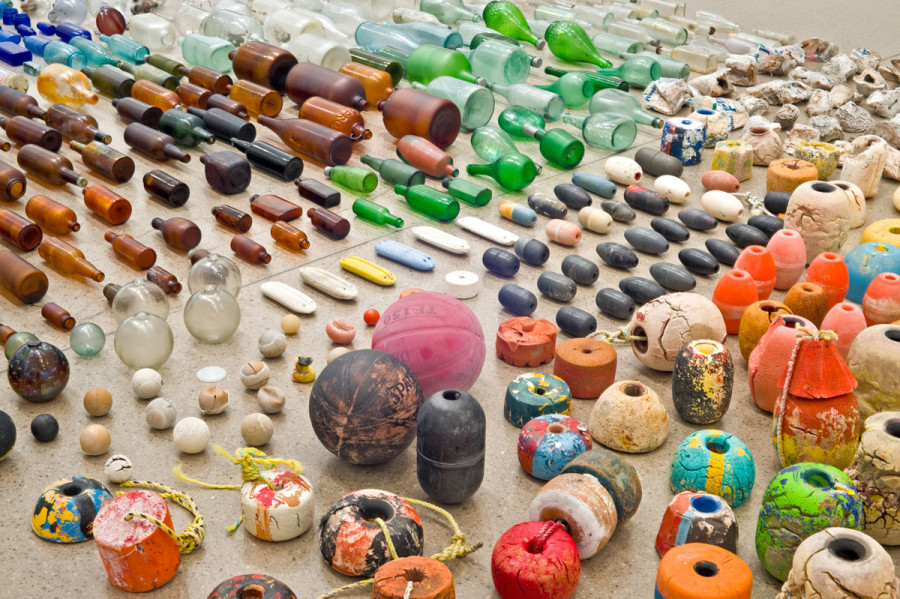
For the 2012 installation "Sandstars," Gabriel Orozco arranged over 1,200 objects from the Isla Loonshit, Mexico trash repository on the Guggenheim Museum'southward floor, accompanied past a dozen big, gridded photographs depicting the individual objects in a studio setting. The plant treasures bring hints of the ignored wastelands into a gallery setting, forcing viewers to confront the furnishings of industrial and commercial pass up.
fourteen. rAndom International's Rain Room
The 2013 phenomenon that was the "Pelting Room" invited MoMA viewers to experience a deluge of falling water without getting wet. According to the museum's description for the exhibition EXPO 1: New York, "the work invites visitors to explore the roles that science, engineering science, and homo ingenuity can play in stabilizing our environs."
15. Agnes Denes'southward Wheatfields
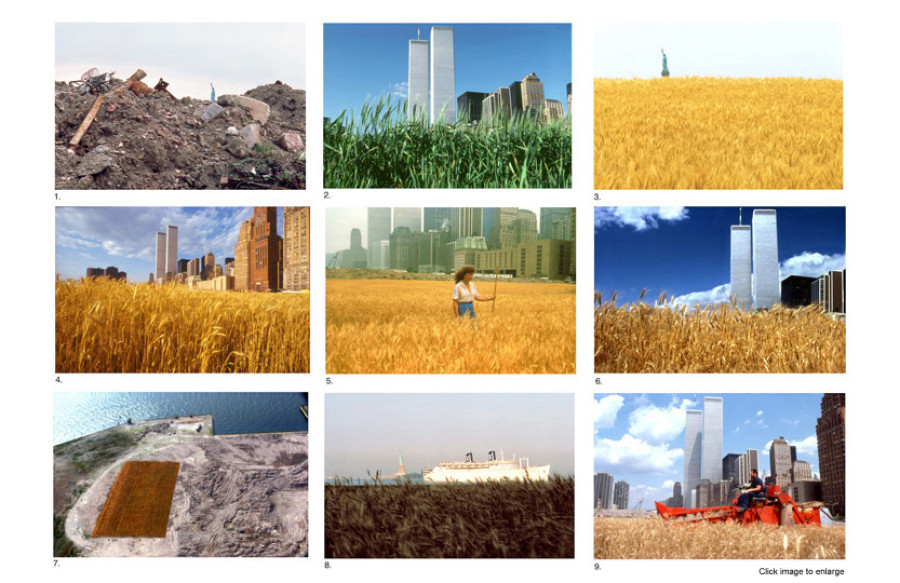
Agnes Denes, Wheatfield, 1982, Courtesy of the creative person and Leslie Tonkonow Artworks + Projects
Agnes Denes is a giant among land artists. Her near well-known projection is probably the 1982 piece "Wheatfield -- A Confrontation," in which she planted a field of golden wheat on ii acres of a landfill nearly Wall Street and the World Trade Heart in Manhattan. She weeded, irrigated and cultivated the mini oasis, bringing the essence of rural America into the throngs of America's urban epicenter. The confrontation was between nature and artifice.
xvi. Christo and Jeanne-Claude'due south Surrounded Islands

Christo and the late Jeanne-Claude are well known for their massive land artworks that serve to remind viewers of the natural wonders scattered effectually the planet. For "Surrounded Islands," the 2 artists encircled 11 islands in Biscayne Bay, Miami with 6.5 million square feet of floating pink woven polypropylene fabric. In the process, they cleaned up twoscore tons of garbage from the floating land masses.
17. Mathilde Roussel's Living Sulptures
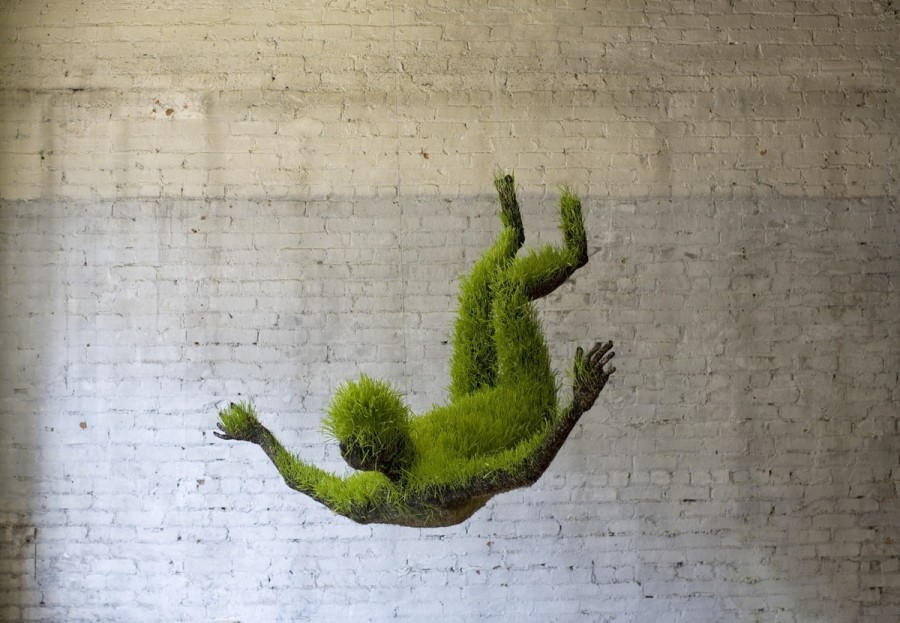
French artist Mathilde Roussel created a serial of living grass installations that have the shape of human beings. Made of recycled cloth and textile filled with soil and wheat grass seeds, the pieces are meant to symbolize the centrality of food. "Observing nature and existence aware of what and how we eat makes united states of america more sensitive to food cycles in the globe -- of abundance, of famine -- and allows usa to be physically, intellectually and spiritually connected to a global reality," the creative person explains.
18. Pedro Reyes' Grasshopper Burgers
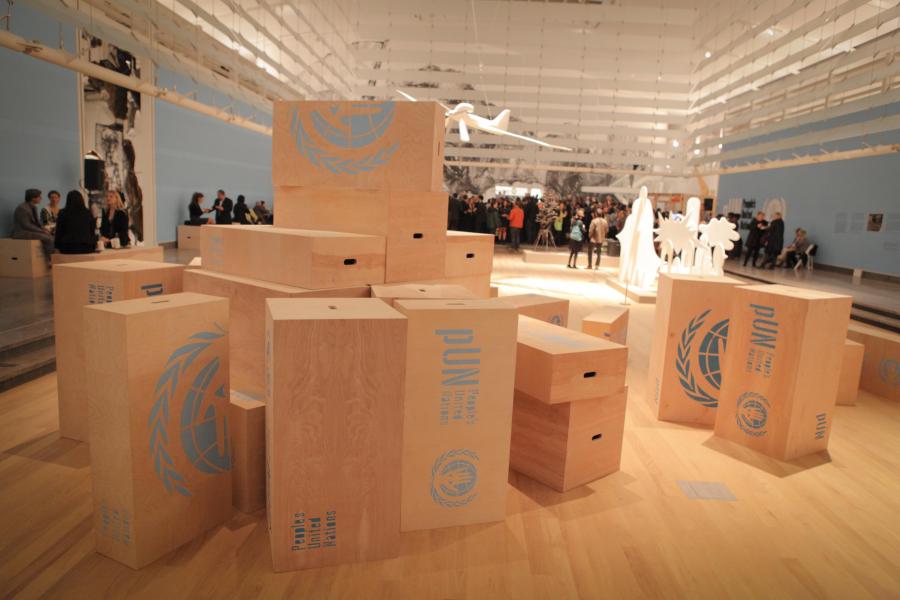
Queens Museum, courtesy Laila Bahman
For "The People's Un (pUN)" exhibition at Queens Museum in New York, Mexican artist Pedro Reyes made climatic change and geo-engineering points of focus for his diplomatic performance piece. He even served grasshopper burgers during a lunch suspension to participants in the 193-person assembly to highlight the carbon footprint of meat. "Protein from insects is the style of the future," the creative person proclaimed to HuffPost.
Source: https://www.huffpost.com/entry/environmental-art_n_5585288
0 Response to "The Role of Fine Art in the Environmental Issues"
Post a Comment